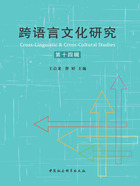
4.Overall Analysis
So far we have separately examined two scenes individually—the bee-chasing scene(Pictures 11-12) and the deer scene(Pictures 15-17).By analyzing the two scenes simultaneously,however,we can get a much clearer picture.With the two scenes’ agency combined,the study has revealed that those narrators who encoded high agency in one language tended to do so in the other,and those who encoded low or no agency in one language showed a similar tendency in the other,rs=.38,p<.05.[As mentioned earlier,the Spearman rank order correlation rho(ρ) is used because the variables for investigation are of ordinal scaling.] With regard to the physical maturation(i.e.,age) and the effect of schooling(i.e.,grade/year in school),Japanese narrations show positive associations:age r=.35,p<.05,year in school r=.45,p<.01.As far as Japanese narration is concerned,as seen earlier in the use of the passive voice in the deer scene,as children age and advance in school,they come to encode agency appropriately in their narrations in Japanese,their mother tongue.
Although weak,a positive association between agency(or causality encoding) of the two scenes was identified in the case of Japanese,rs=.30,p<.09.Those who encoded high agency in Japanese when narrating one scene tended to do the same when narrating the other scene in Japanese.We need to examine different types of narrators separately,however.As seen in Table 12,there are two predominant pairings:(1) nine narrators who consistently encoded high agency in both languages,and(2) 13 narrators who encoded low agency at least once in both languages,χ2(1,31)=6.27,p<.02.Thus,we have consistently found—either when analyzing the chasing and deer scene separately or both scenes combined—that bilinguals schematize a scene in similar or even identical ways,choose an appropriate verb,and encode agency accordingly.
Table 12 Two Scenes Combined(Pictures 11-12,15-17):English and Japanese(Degree of Agency)

Further analyses may reveal each individual case to have different tendencies,but the narrators are basically categorized into four groups:(1) consistent narrators,(2)narrators with scene-specific encoding patterns,(3) narrators with language-specific encoding patterns,and(4) narrators with random and/or inconsistent encoding patterns.
Consistent narrators.Mike,Misa [Girl;Grade 2.6;Age 9 years,2 months],Taichi,Miki [Girl;Grade 2.8;Age 7 years,9 months],Genki [Boy;Grade 3.7;Age 9 years,5 months],Kahori [Girl;Grade 3.8;Age 9 years,7 months],Mai [Girl;Grade 6.7;Age 12 years,0 months],Sayuri [Girl;Grade 6.8;Age 11 years,10 months],and Kazuo consistently encoded high agency in both languages.They understood both scenes in the appropriate ways and were able to encode agency regardless of the language of narration.The nine children in this category may be considered highly balanced bilingual narrators.
Narrators with scene-specific encoding patterns.Six children—Misaki,Momoe [Girl;Grade 2.7;Age 8 years,0 months],Kenta,Taizo,Keigo,and Natsuko—regardless of the language of narration,encoded high agency when describing the chasing scene,but did not opt for doing so in the deer scene.Perhaps they interpreted the two scenes in different ways;while they thought that bees were chasing the dog,they might have inferred that the deer did not necessarily drop the boy but that what happened in Pictures 15-17 was only an accident(the boy unnecessarily surprised the deer;the deer was,in fact,a victim and not to blame).
Koharu omitted the chasing scene when narrating in Japanese,and Takashi [Boy;Grade 5.7;Age 11 years,1 month] omitted the deer scene in his English narration.But if Koharu had narrated the chasing scene in Japanese with high agency encoding,and if Takashi had narrated the deer scene in English with low agency encoding,they might also have belonged to this category.
In this sense,Eimi,seems to be the opposite;that is,while she did not encode high agency when narrating the chasing scene in either language,she did so in both languages when narrating the deer scene.Perhaps she might have empathized with the bees because the dog started the trouble by dropping the beehive.Overall,the narrators belonging to this category might have interpreted the scenes differently.
Narrators with language-specific encoding patterns.Hiro encoded high agency in Japanese in both scenes,but he did not encode high agency in English in either scene.Although he knew how to encode agency in Japanese,he might not have understood how to do it in English.Nichole [Girl;Grade 2.9;Age 7 years,7 months] seemed to be the opposite.She encoded high agency in English in both scenes,but she did not do so in Japanese in either scene.Perhaps she knew what to do in English,but she did not know what to do in Japanese and failed to include causality.
Melissa,Eriko,and Leon,none of whom narrated the chasing scene in English,may belong to this category as well.If this was the case,then,not only Nichole but also these three children might need to be taught how to encode causality in Japanese.Although their mother tongue is Japanese,they may need to develop their Japanese language fluency.
Narrators with random and/or inconsistent encoding patterns.Some other cases also show concerns in the light of bilingual development.Of the five children who missed the narration of the chasing scene in both English and Japanese,Masaaki [Boy;Grade 3.7;Age 9 years,1 month],Jon,and Hanayo did not include any causality.If they did not identify causality in these two pictures,this should not be a matter of concern.If they did understand causality and failed to include it,on the other hand,they may need to be instructed how to encode it.
The remaining 12 narrators showed random and/or inconsistent encoding patterns.Their encoding patterns were not consistent,and they may have encoded high agency in one language but not in the other when narrating the same scene.For instance,Ryu [Boy;Grade 3.7;Age 9 years,2 months] and Sachiko [Girl;Grade 3.6;Age 8 years,9 months] missed encoding agency only once when narrating the deer scene in English and Japanese respectively.
Perhaps potentially more serious cases are Sandy[Girl;Grade 3.9;Age 8 years,8 months],who encoded agency only when narrating the chasing scene in English,and,likewise,Asami [Girl;Grade 2.7;Age 9 years,9 months] and Miho [Girl;Grade 3.6;Age 8 years,3 months],both of whom encoded agency only when narrating the deer scene in English.Children categorized above as narrators with scene-specific and language-specific encoding patterns but who failed to narrate one of the scenes may belong to this group as well.
Table 13 Chasing and Deer Scenes(Pictures 11-12 and 15-17):English & Japanese

续表
